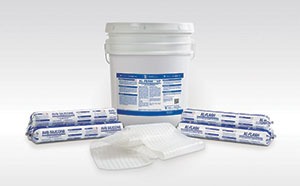Air Barriers and Insulation
Cavity Walls: The Bricks and Mortar for Maximizing Building Envelope Performance

Having a broad scope mason contractor covering cavity wall and exterior cladding on a project is a growing preference for general contractors, largely because of the trade expertise one brings to the building envelope.
For masonry clad projects, these circumstances present mason contractors an opportunity to potentially orchestrate the exterior wall from the framing out. This includes the gypsum sheathing, air and vapor barrier, continuous insulation (CI), water-resistive barrier, flashings and masonry cladding.
When a broader scope of work on the project than just cladding is possible, a greater earning potential is presented. Furthermore, a mason contractor becomes a general contractor’s reliable source for cavity wall construction quality control.
Mason contractors can take exterior wall components to the next level, ensuring maximum building envelope performance, which is not only the goal, but becoming the focus across the United States. These mandates are met using materials such as continuous insulation (CI) – “ci” as it is referenced in The International Energy Conservation Code (IECC) – and air and vapor barriers, which work together to improve thermal performance in buildings.
Continuous insulation
According to the American Society of Heating Refrigeration and Air-Conditioning Engineers (ASHRAE) – an organization aimed at advancing human well-being through sustainable technology for the built environment – CI is required to minimize thermal bridging and help improve thermal performance of a wall assembly.
CI, by definition, is insulation that runs continuously over structural members and is free of significant thermal bridging such as rigid foam insulation above a ceiling deck, the U.S. Department of Energy (DOE) states. This material selection is becoming increasingly crucial, thanks to evolving energy codes throughout the United State that are requiring higher thermal performance values in walls.
Installed on the interior or exterior, and often integral to any opaque surface of a building envelope, CI is an option for building performance to achieve long-term energy savings, DOE resources indicate.
Some of the best CI exterior wall insulations incorporate foam technologies using HCFC-free blowing agents that do not contribute to the depletion of the ozone (non-ODP). Mason contractors also should look for those that offer low global warming potential (low-GWP) and are formaldehyde free. They provide the highest possible R-value per inch as compared with other wall insulation products.
Other crucial CI attributes are:
- Energy code solutions for every climate zone
- Comprehensive, fire-tested wall assembly options
- Dimensional stability in changing climates
- Decreased environmental footprint and increased energy efficiency
Product Watch
|
| Pecora’s XL-Perm Air, Vapor and Water Barrier System consists of products that work together to provide complete protection for a building envelope.
All the products in the Pecora XL Perm system, when used together according to manufacturer’s guidelines, achieve 100 percent compatibility, wet or dry. Complete system testing was done using an assortment of air, vapor and water barrier materials to ensure quality. Now available, Pecora XL-Perm is a professional system that must be used in conformity with manufacturer’s instructions. For more information, visit pecora.com. |
Air and vapor barriers
An air barrier assembly includes a collection of materials such as self-adhered sheet membrane air barriers, liquid-applied membranes, medium-density sprayed polyurethane foam, and mechanically fastened commercial building wraps. Those materials work with air barrier accessories like sealants, tapes and transition membranes in a uniform assembly that creates a continuous barrier.
The International Energy Conservation Code (IECC) and several state energy codes now require the use of air barriers, with a growing number of municipal authorities and green building groups also hailing their use, according to the Air Barrier Association of America (ABAA).
“The performance of an air barrier assembly is of far greater importance than the air permeance of the material,” the ABAA states. “When materials and accessories are installed proficiently, the benefits of the assembly have positive benefits for the entire life cycle of the building.”
That’s where mason contractors come in. This is the trade best able to identify those air and vapor barrier installation needs to create an impermeable barrier by honing in on various key features, including:
- Self-sealing barriers
- Membrane thicknesses
- Consistent installation standards
- Products that meet or exceed required ASTM material standards
Through-wall flashing
The interior of a masonry wall can generate significant heat, often affecting flashings and adjacent masonry. This fact makes through-wall flashing selection and installation crucial to maximize a project’s longevity.
Mason contractors are experts in the placement of flashing – bases of walls, along window sills, over doors, on parapets, and around support angles. They also are well versed in the array of flashing materials available, ranging from formed metals to rubberized asphalt.
Topping the priority list should be longevity, which can be achieved through a high-performance, flexible membrane used to protect masonry walls from water damage. Contractors prefer a tough, resilient flashing with excellent thermal and dimensional stability, as well as superior resistance to weathering, ozone and ultraviolet (UV) radiation.
The ideal flashing for a project will yield several benefits. Among them is the withstanding of harsh conditions – both while on the job site and after installation – and the retaining of flexibility and compatibility with a project’s cavity wall products.
To achieve this, mason contractors should keep these features in mind when selecting the perfect through-wall flashing:
- Strong resistance to UV and ozone
- Flexibility in various temperatures, depending on a project’s climate
- Straight-forward installation
- Resistance to punctures and tears
- Expansion and contraction characteristics
- Durability and long-lasting resistance to corrosion
Mason contractors understand the importance of the compatibility of products used in cavity wall construction in order to optimize energy efficiency. They also can best monitor the integrity on installation within the wall assembly. Most of all, their cavity wall material experience serves to benefit everyone, from architects to building owners.
Cliff Black is building envelope product manager, Firestone Building Products.
